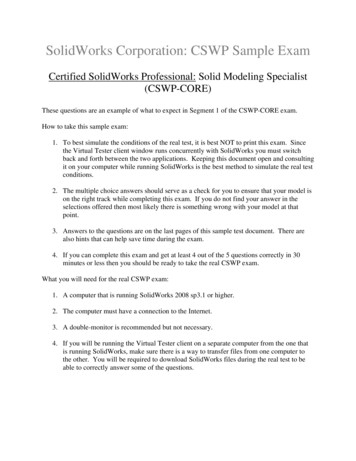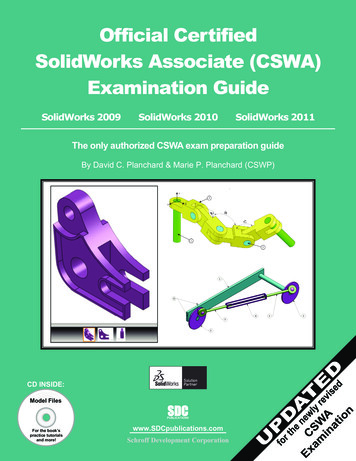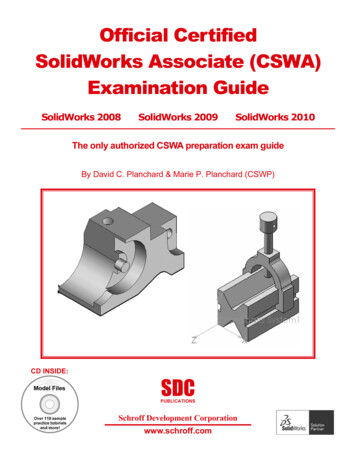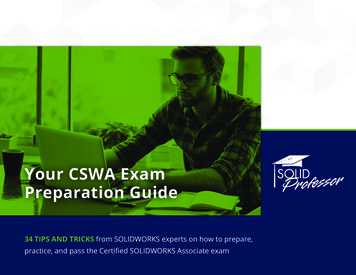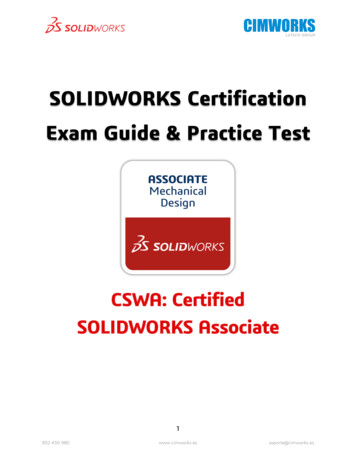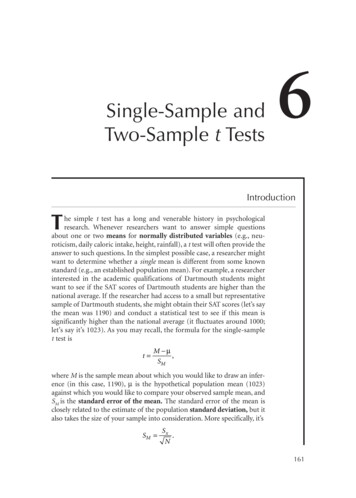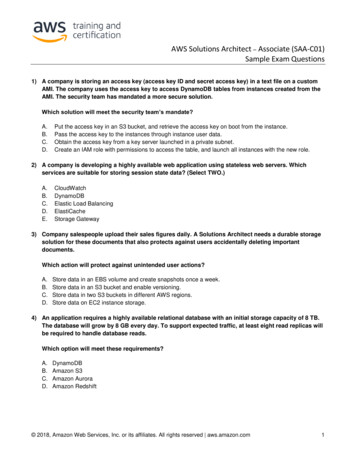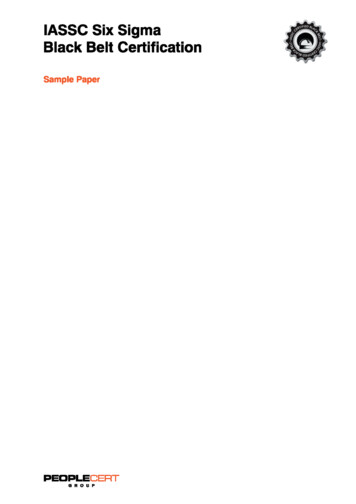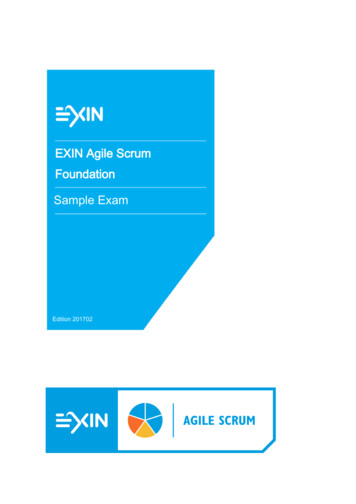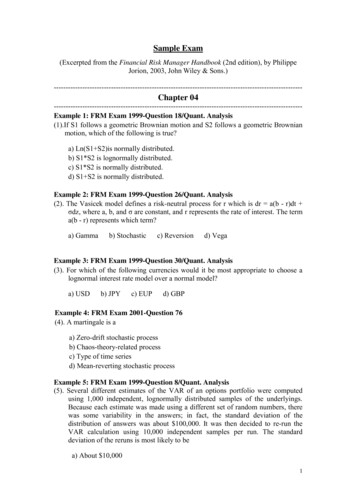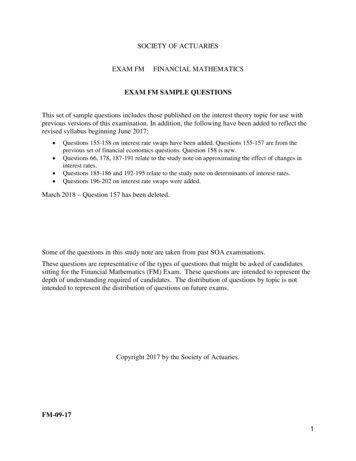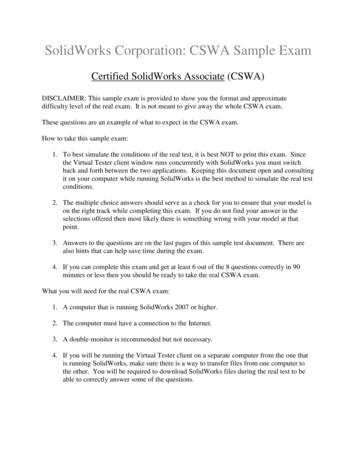
Transcription
SolidWorks Corporation: CSWA Sample ExamCertified SolidWorks Associate (CSWA)DISCLAIMER: This sample exam is provided to show you the format and approximatedifficulty level of the real exam. It is not meant to give away the whole CSWA exam.These questions are an example of what to expect in the CSWA exam.How to take this sample exam:1. To best simulate the conditions of the real test, it is best NOT to print this exam. Sincethe Virtual Tester client window runs concurrently with SolidWorks you must switchback and forth between the two applications. Keeping this document open and consultingit on your computer while running SolidWorks is the best method to simulate the real testconditions.2. The multiple choice answers should serve as a check for you to ensure that your model ison the right track while completing this exam. If you do not find your answer in theselections offered then most likely there is something wrong with your model at thatpoint.3. Answers to the questions are on the last pages of this sample test document. There arealso hints that can help save time during the exam.4. If you can complete this exam and get at least 6 out of the 8 questions correctly in 90minutes or less then you should be ready to take the real CSWA exam.What you will need for the real CSWA exam:1. A computer that is running SolidWorks 2007 or higher.2. The computer must have a connection to the Internet.3. A double-monitor is recommended but not necessary.4. If you will be running the Virtual Tester client on a separate computer from the one thatis running SolidWorks, make sure there is a way to transfer files from one computer tothe other. You will be required to download SolidWorks files during the real test to beable to correctly answer some of the questions.
The following is the topic and question breakdown of the CSWA exam:Drafting Competencies (3 Questions of 5 Points Each): Miscellaneous questions on drafting functionalityBasic Part Creation and Modification (2 Questions of 15 Points Each): Sketching Extrude Boss Extrude Cut Modification of Key DimensionsIntermediate Part Creation and Modification (2 Questions of 15 Points Each): Sketching Revolve Boss Extrude Cut Circular PatternAdvanced Part Creation and Modification (3 Questions of 15 Points Each): Sketching Sketch Offset Extrude Boss Extrude Cut Modification of Key Dimensions More Difficult Geometry ModificationsAssembly Creation (4 Questions of 30 Points Each): Placing of Base Part Mates Modification of Key Parameters in AssemblyTotal Questions: 14Total Points: 240165 out of 240 points needed to pass the CSWA.The sample test below will show the basic format of the CSWA exam in three sections: Drafting CompetenciesPart ModelingAssembly Creation
SAMPLE TESTDrafting Competencies:1. To create drawing view ‘B’ it is necessary to sketch a spline (as shown) on drawing view ‘A’and insert which SolidWorks view type?a)b)c)d)SectionCropProjectedDetail2. To create drawing view ‘B’ it is necessary to sketch a spline (as shown) on drawing view ‘A’and insert which SolidWorks view type?a)b)c)d)Aligned SectionDetailBroken-out SectionSection
Part Modeling: (These images are to be used to answer Questions #3 – 4)
3. Part (Tool Block) - Step 1Build this part in SolidWorks.(Save part after each question in a different file in case it must be reviewed)Unit system: MMGS (millimeter, gram, second)Decimal places: 2Part origin: ArbitraryAll holes through all unless shown otherwise.Material: AISI 1020 SteelDensity 0.0079 g/mm 3A 81.00B 57.00C 43.00What is the overall mass of the part (grams)?Hint: If you don't find an option within 1% of your answer please re-check your solid model.a)b)c)d)1028.33118.93577.64939.544. Part (Tool Block) - Step 2Modify the part in SolidWorks.Unit system: MMGS (millimeter, gram, second)Decimal places: 2Part origin: ArbitraryAll holes through all unless shown otherwise.Material: AISI 1020 SteelDensity 0.0079 g/mm 3Use the part created in the previous question and modify it by changing the followingparameters:A 84.00B 59.00C 45.00Note: Assume all other dimensions are the same as in the previous question.What is the overall mass of the part (grams)?
Part Modeling: (These images are to be used to answer Question #5)
5. Part (Tool Block) - Step 3Modify this part in SolidWorks.Unit system: MMGS (millimeter, gram, second)Decimal places: 2Part origin: ArbitraryAll holes through all unless shown otherwise.Material: AISI 1020 SteelDensity 0.0079 g/mm 3Use the part created in the previous question and modify it by removing material and also bychanging the following parameters:A 86.00B 58.00C 44.00What is the overall mass of the part (grams)?
Part Modeling: (These images are to be used to answer Question #6)
6. Part (Tool Block) - Step 4Modify this part in SolidWorks.Unit system: MMGS (millimeter, gram, second)Decimal places: 2Part origin: ArbitraryAll holes through all unless shown otherwise.Material: AISI 1020 SteelDensity 0.0079 g/mm 3Use the part created in the previous question and modify it by adding a pocket.Note 1: Only one pocket on one side is to be added. This modified part is not symmetrical.Note 2: Assume all unshown dimensions are the same as in the previous question #5.What is the overall mass of the part (grams)?
Assembly Modeling: (These images are to be used to answer Question #7 and 8)
7. Build this assembly in SolidWorks (Chain Link Assembly)It contains 2 long pins (1), 3 short pins (2), and 4 chain links (3).Unit system: MMGS (millimeter, gram, second)Decimal places: 2Assembly origin: Arbitrary-Download the attached zip file and open it.-Save the contained parts and open those parts in SolidWorks. (Note: If SolidWorks prompts"Do you want to proceed with feature recognition?" please click "No".)-IMPORTANT: Create the Assembly with respect to the Origin as shown in isometric view.(This is important for calculating the proper Center of Mass)-Create the assembly using the following conditions:1. Pins are mated concentric to chain link holes (no clearance).2. Pin end faces are coincident to chain link side faces.A 25 degreesB 125 degreesC 130 degreesWhat is the center of mass of the assembly (millimeters)?Hint: If you don't find an option within 1% of your answer please re-check your assembly.a)b)c)d)X 348.66, Y -88.48, Z -91.40X 308.53, Y -109.89, Z -61.40X 298.66, Y -17.48, Z -89.22X 448.66, Y -208.48, Z -34.64
8. Modify this assembly in SolidWorks (Chain Link Assembly)Unit system: MMGS (millimeter, gram, second)Decimal places: 2Assembly origin: Arbitrary-Using the same assembly created in the previous question modify the following parameters:A 30 degreesB 115 degreesC 135 degreesWhat is the center of mass of the assembly (millimeters)?
Answers:1.2.3.4.5.6.7.8.b) Cropc) Broken-out Sectiond) 939.54 g1032.32 g628.18 g432.58 ga) X 348.66, Y -88.48, Z -91.40X 327.67, Y -98.39, Z -102.91Hints and Tips:Hint #1: To prepare for the Drafting Competencies section of the CSWA, review all the drawingviews that can be created. These commands can be found by opening any drawing and going tothe View Layout command manager toolbar or in the menu Insert Drawing View.Hint #2: For a detailed explanation of each View type, access the individual feature Help sectionby selecting the Help icon in the Feature Manager for that View Feature:
Hint #3: For a description and walk-through of the VirtualTester testing client, please go to theselinks: Starting the exam: rting the exam/ During the exam: ing the exam/ Ending the exam: ing the exam/
Certified SolidWorks Associate (CSWA) DISCLAIMER: This sample exam is provided to show you the format and approximate difficulty level of the real exam. It is not meant to give away the whole CSWA exam. These questions are an example of what to expect in the CSWA exam. How to take this sample exam: 1. To best simulate the conditions of the real test, it is best NOT to print this exam. SinceFile Size: 547KBPage Count: 14
